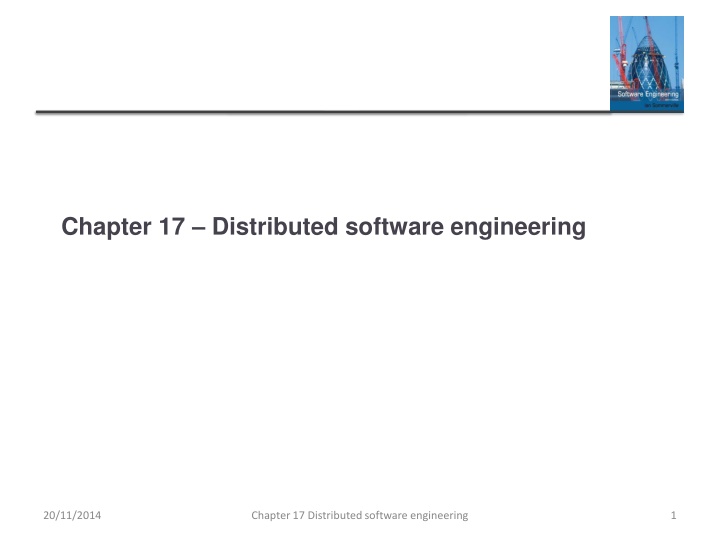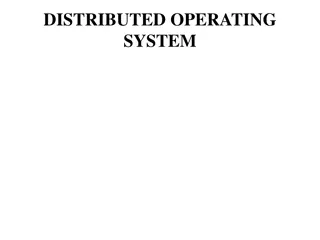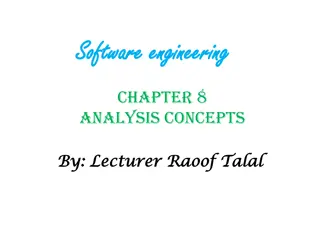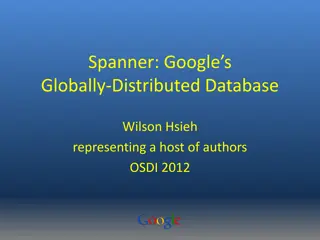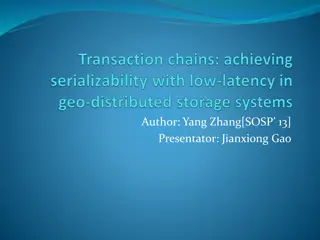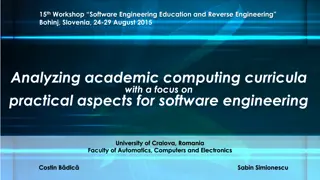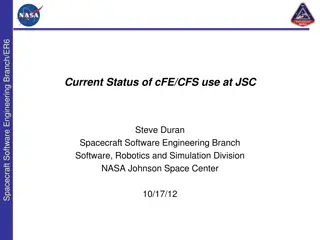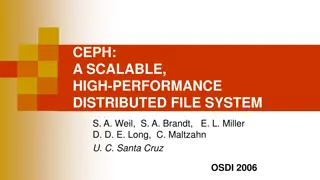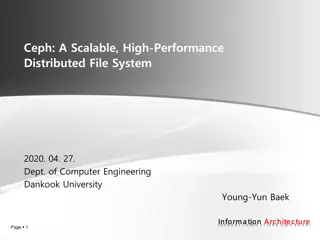Distributed Software Engineering Overview
Distributed software engineering plays a crucial role in modern enterprise computing systems where large computer-based systems are distributed over multiple computers for improved performance, fault tolerance, and scalability. This involves resource sharing, openness, concurrency, and fault tolerance. Design issues revolve around transparency, openness, scalability, security, quality of service, and failure management in distributed systems.
Download Presentation

Please find below an Image/Link to download the presentation.
The content on the website is provided AS IS for your information and personal use only. It may not be sold, licensed, or shared on other websites without obtaining consent from the author.If you encounter any issues during the download, it is possible that the publisher has removed the file from their server.
You are allowed to download the files provided on this website for personal or commercial use, subject to the condition that they are used lawfully. All files are the property of their respective owners.
The content on the website is provided AS IS for your information and personal use only. It may not be sold, licensed, or shared on other websites without obtaining consent from the author.
E N D
Presentation Transcript
Chapter 17 Distributed software engineering 20/11/2014 Chapter 17 Distributed software engineering 1
Topics covered Distributed systems Client server computing Architectural patterns for distributed systems Software as a service 20/11/2014 Chapter 17 Distributed software engineering 2
Distributed systems Virtually all large computer-based systems are now distributed systems. a collection of independent computers that appears to the user as a single coherent system. Information processing is distributed over several computers rather than confined to a single machine. Distributed software engineering is therefore very important for enterprise computing systems. 20/11/2014 Chapter 17 Distributed software engineering 3
Distributed system characteristics Resource sharing Sharing of hardware and software resources. Openness Use of equipment and software from different vendors. Concurrency Concurrent processing to enhance performance. Scalability Increased throughput by adding new resources. Fault tolerance The ability to continue in operation after a fault has occurred. 20/11/2014 Chapter 17 Distributed software engineering 4
Distributed systems 20/11/2014 Chapter 17 Distributed software engineering 5
Distributed systems issues Distributed systems are more complex than systems that run on a single processor. Complexity arises because different parts of the system are independently managed as is the network. There is no single authority in charge of the system so top-down control is impossible. 20/11/2014 Chapter 17 Distributed software engineering 6
Design issues Transparency To what extent should the distributed system appear to the user as a single system? Openness Should a system be designed using standard protocols that support interoperability? Scalability How can the system be constructed so that it is scaleable? Security How can usable security policies be defined and implemented? Quality of service How should the quality of service be specified. Failure management How can system failures be detected, contained and repaired? 20/11/2014 Chapter 17 Distributed software engineering 7
Transparency Ideally, users should not be aware that a system is distributed and services should be independent of distribution characteristics. In practice, this is impossible because parts of the system are independently managed and because of network delays. Often better to make users aware of distribution so that they can cope with problems To achieve transparency, resources should be abstracted and addressed logically rather than physically. Middleware maps logical to physical resources. 20/11/2014 Chapter 17 Distributed software engineering 8
Openness Open distributed systems are systems that are built according to generally accepted standards. Components from any supplier can be integrated into the system and can inter-operate with the other system components. Openness implies that system components can be independently developed in any programming language and, if these conform to standards, they will work with other components. Web service standards for service-oriented architectures were developed to be open standards. 20/11/2014 Chapter 17 Distributed software engineering 9
Scalability The scalability of a system reflects its ability to deliver a high quality service as demands on the system increase Size It should be possible to add more resources to a system to cope with increasing numbers of users. Distribution It should be possible to geographically disperse the components of a system without degrading its performance. Manageability It should be possible to manage a system as it increases in size, even if parts of the system are located in independent organizations. There is a distinction between scaling-up and scaling- out. Scaling up is more powerful system; scaling out is more system instances. 20/11/2014 Chapter 17 Distributed software engineering 10
Security When a system is distributed, the number of ways that the system may be attacked is significantly increased, compared to centralized systems. If a part of the system is successfully attacked then the attacker may be able to use this as a back door into other parts of the system. Difficulties in a distributed system arise because different organizations may own parts of the system. These organizations may have mutually incompatible security policies and security mechanisms. 20/11/2014 Chapter 17 Distributed software engineering 11
Types of attack The types of attack that a distributed system must defend itself against are: Interception, where communications between parts of the system are intercepted by an attacker so that there is a loss of confidentiality. Interruption, where system services are attacked and cannot be delivered as expected. Denial of service attacks involve bombarding a node with illegitimate service requests so that it cannot deal with valid requests. Modification, where data or services in the system are changed by an attacker. Fabrication, where an attacker generates information that should not exist and then uses this to gain some privileges. 20/11/2014 Chapter 17 Distributed software engineering 12
Quality of service The quality of service (QoS) offered by a distributed system reflects the system s ability to deliver its services dependably and with a response time and throughput that is acceptable to its users. Quality of service is particularly critical when the system is dealing with time-critical data such as sound or video streams. In these circumstances, if the quality of service falls below a threshold value then the sound or video may become so degraded that it is impossible to understand. 20/11/2014 Chapter 17 Distributed software engineering 13
Failure management In a distributed system, it is inevitable that failures will occur, so the system has to be designed to be resilient to these failures. You know that you have a distributed system when the crash of a system that you ve never heard of stops you getting any work done. Distributed systems should include mechanisms for discovering if a component of the system has failed, should continue to deliver as many services as possible in spite of that failure and, as far as possible, automatically recover from the failure. 20/11/2014 Chapter 17 Distributed software engineering 14
Models of interaction Two types of interaction between components in a distributed system Procedural interaction, where one computer calls on a known service offered by another computer and waits for a response. Message-based interaction, involves the sending computer sending information about what is required to another computer. There is no necessity to wait for a response. 20/11/2014 Chapter 17 Distributed software engineering 15
Procedural interaction between a diner and a waiter 20/11/2014 Chapter 17 Distributed software engineering 16
Message-based interaction between a waiter and the kitchen <starter> </starter> <main course> </main> <accompaniment> </accompaniment> <dish name = soup type = tomato /> <dish name = soup type = fish /> <dish name = pigeon salad /> <dish name = steak type = sirloin cooking = medium /> <dish name = steak type = fillet cooking = rare /> <dish name = sea bass > <dish name = french fries portions = 2 /> <dish name = salad portions = 1 /> 20/11/2014 Chapter 17 Distributed software engineering 17
Remote procedure calls Procedural communication in a distributed system is implemented using remote procedure calls (RPC). In a remote procedure call, one component calls another component as if it was a local procedure or method. The middleware in the system intercepts this call and passes it to a remote component. This carries out the required computation and, via the middleware, returns the result to the calling component. A problem with RPCs is that the caller and the callee need to be available at the time of the communication, and they must know how to refer to each other. 20/11/2014 Chapter 17 Distributed software engineering 18
Message passing Message-based interaction normally involves one component creating a message that details the services required from another component. Through the system middleware, this is sent to the receiving component. The receiver parses the message, carries out the computations and creates a message for the sending component with the required results. In a message-based approach, it is not necessary for the sender and receiver of the message to be aware of each other. They simple communicate with the middleware. 20/11/2014 Chapter 17 Distributed software engineering 19
Middleware The components in a distributed system may be implemented in different programming languages and may execute on completely different types of processor. Models of data, information representation and protocols for communication may all be different. Middleware is software that can manage these diverse parts, and ensure that they can communicate and exchange data. 20/11/2014 Chapter 17 Distributed software engineering 20
Middleware in a distributed system 20/11/2014 Chapter 17 Distributed software engineering 21
Middleware support Interaction support, where the middleware coordinates interactions between different components in the system The middleware provides location transparency in that it isn t necessary for components to know the physical locations of other components. The provision of common services, where the middleware provides reusable implementations of services that may be required by several components in the distributed system. By using these common services, components can easily inter- operate and provide user services in a consistent way. 20/11/2014 Chapter 17 Distributed software engineering 22
Client-server computing 20/11/2014 Chapter 17 Distributed software engineering 23
Client-server computing Distributed systems that are accessed over the Internet are normally organized as client-server systems. In a client-server system, the user interacts with a program running on their local computer (e.g. a web browser or mobile application). This interacts with another program running on a remote computer (e.g. a web server). The remote computer provides services, such as access to web pages, which are available to external clients. 20/11/2014 Chapter 17 Distributed software engineering 24
Clientserver interaction 20/11/2014 Chapter 17 Distributed software engineering 25
Mapping of clients and servers to networked computers 20/11/2014 Chapter 17 Distributed software engineering 26
Layered architectural model for clientserver applications 20/11/2014 Chapter 17 Distributed software engineering 27
Layers in a client/server system Presentation concerned with presenting information to the user and managing all user interaction. Data handling manages the data that is passed to and from the client. Implement checks on the data, generate web pages, etc. Application processing layer concerned with implementing the logic of the application and so providing the required functionality to end users. Database Stores data and provides transaction management services, etc. 20/11/2014 Chapter 17 Distributed software engineering 28
Architectural patterns for distributed systems 20/11/2014 Chapter 17 Distributed software engineering 29
Architectural patterns Widely used ways of organizing the architecture of a distributed system: Master-slave architecture, which is used in real-time systems in which guaranteed interaction response times are required. Two-tier client-server architecture, which is used for simple client-server systems, and where the system is centralized for security reasons. Multi-tier client-server architecture, which is used when there is a high volume of transactions to be processed by the server. Distributed component architecture, which is used when resources from different systems and databases need to be combined, or as an implementation model for multi-tier client-server systems. Peer-to-peer architecture, which is used when clients exchange locally stored information and the role of the server is to introduce clients to each other 20/11/2014 Chapter 17 Distributed software engineering 30
Master-slave architectures Master-slave architectures are commonly used in real- time systems where there may be separate processors associated with data acquisition from the system s environment, data processing and computation and actuator management. The master process is usually responsible for computation, coordination and communications and it controls the slave processes. Slave processes are dedicated to specific actions, such as the acquisition of data from an array of sensors. 20/11/2014 Chapter 17 Distributed software engineering 31
A traffic management system with a master- slave architecture 20/11/2014 Chapter 17 Distributed software engineering 32
Two-tier client server architectures In a two-tier client-server architecture, the system is implemented as a single logical server plus an indefinite number of clients that use that server. Thin-client model, where the presentation layer is implemented on the client and all other layers (data management, application processing and database) are implemented on a server. Fat-client model, where some or all of the application processing is carried out on the client. Data management and database functions are implemented on the server. 20/11/2014 Chapter 17 Distributed software engineering 33
Thin- and fat-client architectural models 20/11/2014 Chapter 17 Distributed software engineering 34
Thin client model Used when legacy systems are migrated to client server architectures. The legacy system acts as a server in its own right with a graphical interface implemented on a client. A major disadvantage is that it places a heavy processing load on both the server and the network. 20/11/2014 Chapter 17 Distributed software engineering 35
Fat client model More processing is delegated to the client as the application processing is locally executed. Most suitable for new C/S systems where the capabilities of the client system are known in advance. More complex than a thin client model especially for management. New versions of the application have to be installed on all clients. 20/11/2014 Chapter 17 Distributed software engineering 36
A fat-client architecture for an ATM system 20/11/2014 Chapter 17 Distributed software engineering 37
Thin and fat clients Distinction between thin and fat client architectures has become blurred Javascript allows local processing in a browser so fat- client functionality available without software installation Mobile apps carry out some local processing to minimize demands on network Auto-update of apps reduces management problems There are now very few thin-client applications with all processing carried out on remote server. 20/11/2014 Chapter 17 Distributed software engineering 38
Multi-tier client-server architectures In a multi-tier client server architecture, the different layers of the system, namely presentation, data management, application processing, and database, are separate processes that may execute on different processors. This avoids problems with scalability and performance if a thin-client two-tier model is chosen, or problems of system management if a fat-client model is used. 20/11/2014 Chapter 17 Distributed software engineering 39
Three-tier architecture for an Internet banking system 20/11/2014 Chapter 17 Distributed software engineering 40
Use of clientserver architectural patterns Architecture Two-tier client server architecture with thin clients Applications Legacy system applications that are used when separating application processing and data management is impractical. Clients may access these as services, as discussed in Section 18.4. Computationally intensive applications such as compilers with little or no data management. Data-intensive applications (browsing and querying) with nonintensive application processing. Browsing the Web is the most common example of a situation where this architecture is used. 20/11/2014 Chapter 17 Distributed software engineering 41
Use of clientserver architectural patterns Architecture Two-tier client-server architecture with fat clients Applications Applications where application processing is provided by off-the-shelf software (e.g., Microsoft Excel) on the client. Applications where computationally intensive processing of data (e.g., data visualization) is required. Mobile applications where internet connectivity cannot be guaranteed. Some local processing using cached information from the database is therefore possible. Large-scale applications with hundreds or thousands of clients. Applications where both the data and the application are volatile. Applications where data from multiple sources are integrated. Multi-tier client server architecture 20/11/2014 Chapter 17 Distributed software engineering 42
Distributed component architectures There is no distinction in a distributed component architecture between clients and servers. Each distributable entity is a component that provides services to other components and receives services from other components. Component communication is through a middleware system. 20/11/2014 Chapter 17 Distributed software engineering 43
A distributed component architecture 20/11/2014 Chapter 17 Distributed software engineering 44
Benefits of distributed component architecture It allows the system designer to delay decisions on where and how services should be provided. It is a very open system architecture that allows new resources to be added as required. The system is flexible and scalable. It is possible to reconfigure the system dynamically with objects migrating across the network as required. 20/11/2014 Chapter 17 Distributed software engineering 45
A distributed component architecture for a data mining system 20/11/2014 Chapter 17 Distributed software engineering 46
Disadvantages of distributed component architecture Distributed component architectures suffer from two major disadvantages: They are more complex to design than client server systems. Distributed component architectures are difficult for people to visualize and understand. Standardized middleware for distributed component systems has never been accepted by the community. Different vendors, such as Microsoft and Sun, have developed different, incompatible middleware. As a result of these problems, service-oriented architectures are replacing distributed component architectures in many situations. 20/11/2014 Chapter 17 Distributed software engineering 47
Peer-to-peer architectures Peer to peer (p2p) systems are decentralised systems where computations may be carried out by any node in the network. The overall system is designed to take advantage of the computational power and storage of a large number of networked computers. Most p2p systems have been personal systems but there is increasing business use of this technology. 20/11/2014 Chapter 17 Distributed software engineering 48
Peer-to-peer systems File sharing systems based on the BitTorrent protocol Messaging systems such as Jabber Payments systems Bitcoin Databases Freenet is a decentralized database Phone systems Viber Computation systems - SETI@home 20/11/2014 Chapter 17 Distributed software engineering 49
P2p architectural models The logical network architecture Decentralised architectures; Semi-centralised architectures. Application architecture The generic organisation of components making up a p2p application. Focus here on network architectures. 20/11/2014 Chapter 17 Distributed software engineering 50
